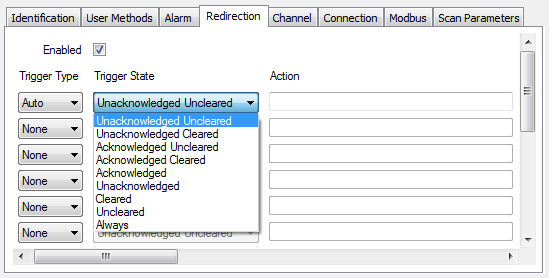The Trigger State applies to redirection actions that are to trigger automatically, manually, or both manually and automatically (see Define the Trigger Type).
The Trigger State is the alarm state that causes an alarm to be redirected. For example, if the Trigger State is set to Unacknowledged Uncleared, each new Unacknowledged Uncleared alarm for the selected database item will be redirected.
To define a Trigger State:
- Ensure that the Enabled check box is selected so that the item’s alarms can be redirected (see Enable or Disable Alarm Redirections for a Database Item).
- Select the required Trigger State from one of the 15 Trigger State combo boxes.
We recommend that you use the top Trigger State combo box for the first alarm redirection, and use the lower combo boxes for subsequent alarm redirections.

The Trigger States are:
- Unacknowledged Uncleared—The redirection action, roster, or calendar triggers when a new alarm is raised.
- Unacknowledged Cleared—The redirection action, roster, or calendar triggers whenever an alarm has cleared but the original alarm occurrence has not been acknowledged.
- Acknowledged Uncleared—The redirection action, roster, or calendar triggers when an alarm is acknowledged but the alarm occurrence has not cleared.
- Acknowledged Cleared—The redirection action, roster, or calendar triggers whenever a cleared alarm is acknowledged or an acknowledged alarm clears.
- Acknowledged—The redirection action, roster, or calendar triggers whenever an alarm is acknowledged, whether or not the alarm state still exists.
- Unacknowledged—The redirection action, roster, or calendar triggers whenever an alarm remains unacknowledged, whether or not the alarm state still exists.
- Cleared—The redirection action, roster, or calendar triggers whenever an alarm clears, whether or not an operator has acknowledged the alarm.
- Uncleared—The redirection action, roster, or calendar triggers if the item remains in an alarm state, regardless of whether an operator has acknowledged the alarm.
- Always—The redirection action, roster, or calendar triggers whenever an alarm changes state.
For more information about the various alarm states, see Alarm Status in the ClearSCADA Guide to Alarms.
When you have selected a Trigger State for an alarm redirection, you need to Select the Action to be Taken.
ClearSCADA can be configured to trigger a particular Method Action immediately, whenever an alarm state change occurs, regardless of the alarm priority or when the alarm changes state. If this is required, consider whether to configure a Method on the Alarm tab of a Form (see Configure a Method Action to Trigger at Every Alarm State Change in the ClearSCADA Guide to Core Configuration). Configuring a Method Action this way allows the Method to be triggered even when, for example, alarms are disabled for the item.